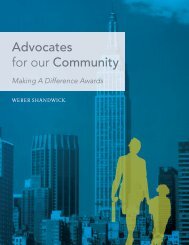White Paper - Weber Shandwick
White Paper - Weber Shandwick
White Paper - Weber Shandwick
Create successful ePaper yourself
Turn your PDF publications into a flip-book with our unique Google optimized e-Paper software.
In today’s highly social and information-driven world,<br />
it is incumbent on companies and other organizations<br />
to match the social style of communication that<br />
employees, customers and other audiences have grown<br />
accustomed to in their daily lives. That means<br />
providing access to volumes of engrossing information<br />
and the ability to engage socially with nearly everyone.<br />
Google provides immediate answers to our questions while<br />
illuminating things we never thought to ask; YouTube<br />
shows us how to play guitar, change a tire or plant a tulip;<br />
Facebook connects us with people we know and those we<br />
thought we’d never hear from again; and Twitter ties us to<br />
people we may well never meet but can gain value from<br />
“knowing.” All the while, smart phones and tablets make<br />
this possible virtually anywhere at any time, and do so while<br />
taking full advantage of videos, images and photography. informative<br />
relationship with the public.<br />
1
T<br />
his easy access to highly visual information and social connectivity<br />
has contributed to the expectation – however unrealistic<br />
at times – that companies develop a similarly social and informative<br />
relationship with the public.<br />
The majority of traditional news media understand this expectation<br />
already. They now present their stories in multiple formats,<br />
understanding that consumers expect a variety of options, both in<br />
where they get their news and how they absorb it. For example,<br />
any given CNN story is produced in several different mediums:<br />
a text-based story, a video, graphic images, photographs and<br />
anchor and reporter blogs and tweets.<br />
Traditional media also understand that not everyone will visit their<br />
homepage or pick up their front page. So they distribute their<br />
stories across as many platforms as possible to maximize viewership.<br />
Links to articles are likewise tweeted, or shared on Facebook. Media<br />
blogs and other aggregators post or link to stories and write about<br />
them on their own “main” news sites. Stories are reconstituted for<br />
YouTube. In short, traditional media outlets understand the need for<br />
multiple platforms and formats when it comes to getting their news<br />
absorbed. They also know they must provide a means for their audiences<br />
to talk right back, both to them and to others in the crowd.<br />
Apple summed all this up in a recent TV advertisement: “Now, we<br />
can watch a newspaper, listen to a magazine ...” In five seconds they<br />
captured the transcendence of information over format. It’s beyond<br />
text, more than a website or print publication. It’s mobile, it’s in our<br />
hands wherever we go. We can watch it, hear it, touch it, respond to<br />
it and – most critically, perhaps – share it. Never has the word multimedia<br />
taken on more meaning in our society.<br />
This change plays out as the merging of once-discrete parts of<br />
the communications industry – i.e., fusions – where the reactions<br />
change how we work with the media, our clients, our colleagues and<br />
the public.<br />
2
client<br />
media<br />
the new<br />
publisher<br />
Where everyone with a smart<br />
phone is a reporter and anyone<br />
with Internet access is a publisher,<br />
it is clear that we are<br />
the media. While traditional<br />
media still drives much of the<br />
news and helps distill thousands<br />
of points of view into<br />
concrete stories, the fusion<br />
between audience and author<br />
exists in virtually every story<br />
from The New York Times<br />
to Twitter. “Pitching” the media<br />
means, in part, talking to<br />
everyone.<br />
text marketing<br />
the new<br />
story<br />
Organizations can no longer<br />
produce content in one medium.<br />
Graphics, photography<br />
and video are as strategic and<br />
essential as the written word<br />
in our profession today and<br />
must accompany our outreach<br />
to media, both traditional<br />
and social.<br />
3<br />
the new<br />
discipline<br />
people video<br />
interactive<br />
Publisher Fusion<br />
media +<br />
client + people<br />
audio<br />
Story Fusion<br />
text + image +<br />
audio + video<br />
image<br />
public<br />
relations<br />
advertising<br />
Discipline Fusion<br />
marketing + public relations +<br />
advertising + interactive<br />
Is a company’s Facebook page<br />
marketing, advertising, interactive<br />
or public relations?<br />
All four, of course. Even TV<br />
ads are not just “advertising”<br />
anymore; they live online,<br />
sparking comments by fans<br />
and foes alike, creating<br />
opportunities and obstacles<br />
for all four disciplines. We<br />
are written, digital and visual<br />
communicators needing to<br />
put forth messages in multiple<br />
formats. Most importantly,<br />
communications today means<br />
dialogue: We must respond<br />
with value to questions and<br />
comments about the messages<br />
we deliver.
Are we telling<br />
stories “inline”<br />
with the new ways<br />
media produce<br />
and people absorb<br />
information?<br />
Are we meeting<br />
the “social”<br />
expectations of<br />
our audiences?<br />
This raises two important questions:<br />
1. Are we supplementing the text we have always provided<br />
to media with video, images and graphics to tell stories<br />
– “inline” with the new ways media produce and people<br />
absorb information?<br />
2. Are we producing a variety of stories, formats and destinations<br />
to become more “social” – inline with the expectations<br />
of our audiences?<br />
The answer is a partial yes to both questions. But PR professionals<br />
need to make two key changes to reach a full yes. The first is<br />
relatively simple: begin providing traditional media with assets<br />
beyond the written word. Accepting that stories are no longer solely<br />
a string of sentences, organizations need to present their news in<br />
multiple formats for delivery to the media. There are a relatively<br />
few formats, of course: text, image, photograph, audio, video. Not<br />
all stories need use all five formats, but all news can take advantage<br />
of more than one. Each news release distributed should be<br />
recalibrated to tell the same news via video, graphics and imagery –<br />
because that’s how the media will retell the story, ultimately reaching<br />
a larger and more engaged audience as a result.<br />
The second question is more challenging. For many organizations<br />
it requires an internal operational change, restructuring how stories<br />
are told and who is doing the telling within the organization. This<br />
change requires that an organization become its own media outlet,<br />
publishing a wider array of content than what was traditionally<br />
considered to be “news” and doing so via its own channels. This<br />
does not mean creating a story for its own sake. It means producing<br />
real stories, strategically chosen, produced in multiple formats and<br />
widely distributed. And once that content is published, it needs to<br />
be open for discussion between the public and the organization<br />
that distributed it.<br />
<strong>Weber</strong> <strong>Shandwick</strong> has defined a communications framework that helps an<br />
organization address both of these questions: Content Fusion.<br />
Content Fusion defines an organization’s own unique storytelling ecosystem by identifying<br />
stories that can best be told in each respective format and driving the stories accordingly.<br />
Publishing and promoting the stories online through all available means ignites public<br />
conversations, connecting a company with its constituents, and realizing the promise of<br />
heightened information-sharing and socialization.<br />
4
Content Fusion should not be regarded as social media-centric.<br />
It’s broader than that, a comprehensive storytelling or newssharing<br />
framework that identifies where to develop news, how to<br />
produce it, where to put it and describes what to do once the<br />
news is out. While it uses social media tools and channels, it also<br />
uses every traditional media channel as well.<br />
Nor is Content Fusion merely a consumer proposition. Industries<br />
and advocates across the spectrum – high-tech, healthcare,<br />
government, agriculture, financial services – that benefit from<br />
being perceived as thought leaders stand to benefit from socializing<br />
their content and communicating it visually. Content Fusion,<br />
properly executed, can amplify the impact and extend the reach<br />
of symposia and seminars, conferences, white papers and reports,<br />
the pillars of business-to-business communication.<br />
Additionally, the humanization inherent in online social networks<br />
enhances employee retention/recruitment. Some 96 percent of<br />
millennials, the developing workforce, have joined a social network.<br />
Graduates today expect a company both to be genuine<br />
and to be present in their lives.<br />
Lastly, successful issues/crisis management hinges on an organization’s<br />
ability to respond quickly and with transparency. Crises<br />
today play out as dialogues, not a sequence of dictated statements<br />
from the organization under the microscope over the<br />
duration of the crisis. Without establishing its presence as a social<br />
organization, a company is unable to make itself heard as well or<br />
as credibly as it could in an authentic two-way exchange.<br />
In The Power of the Post-Recession Consumer, Booz + Co includes an insight that on first blush may<br />
appear to be unrelated to social media. In analyzing the change in consumer behavior resulting from the<br />
recent recession, the report notes that Americans developed a dramatically different set of expectations<br />
from companies. Desire for qualities of “kindness and empathy” rose 391 percent over pre-recession levels,<br />
“friendly” was up 148 percent and “socially responsible” up 63 percent.<br />
“Between 2005 and 2009, U.S. consumers expressed a nearly fourfold increase in their preference for companies,<br />
brands, and products that show kindness in both their operations and their encounters with customers,”<br />
the report said. “This desire for companies to be more empathetic toward consumers is the biggest shift<br />
in any attitude that we have ever seen during the BAV survey’s two-decade history.”<br />
Future sociology professors will probably have a better answer than we have today on what precisely makes<br />
people in our time seek a more intimate relationship with organizations. Is it driven by new technologies,<br />
human social instinct, the recession … or some other unknown factor? Meanwhile, we must help our clients<br />
respond effectively to these new demands in the marketplace.<br />
5<br />
social<br />
responsibility<br />
63 %<br />
kindness<br />
& empathy<br />
391 %<br />
friendliness<br />
148 %<br />
WHAT<br />
AMERICANS<br />
WANT<br />
from companies today<br />
as compared to pre-recession opinions<br />
The Power of the Post-Recession Consumer,<br />
Booz + Co
How Content Fusion Works<br />
Content Fusion uses six key drivers to help an organization achieve its business objectives in this new<br />
environment: listening, stories, formats, vehicles, destinations and conversations. These drivers work<br />
toward establishing an organization as a publisher of its own “news” in a wide array of mediums and<br />
destinations, the end result being an increasing level of trust amongst its key audiences and the public.<br />
listening<br />
Any successful social media campaign begins with listening to<br />
the current conversations that surround your organization and its<br />
industry. Knowing what matters to your constituents and what kind<br />
of knowledge they are seeking is key to the Content Fusion framework.<br />
Listening informs an organization about which stories will<br />
best resonate and in which destination they will ring most true. A<br />
story told in the wrong place to the wrong audience is a waste of<br />
resources and may lead to other negative consequences.<br />
stories<br />
Every organization has unique stories. These stories come from<br />
within the heart of the organization: its people, events, knowledge,<br />
data, research, science, etc. Identifying these stories helps a company<br />
move toward becoming its own news outlet, producing<br />
content beyond what was once considered “news.” We’re not<br />
talking about corporate “fluff” or content for content’s sake. Nor<br />
are we talking about a high volume of stories, but rather a few,<br />
strategically distributed. We’re talking about real, meaningful,<br />
informative stories only that organization could create. Sometimes<br />
they are entertaining. Sometimes they are analytical, or insightful,<br />
or research-driven … hopefully it’s some combination of all of<br />
these and more.<br />
Consider the example of a hypothetical corporate scientist in<br />
Argentina researching plants in search of an enzyme to develop<br />
a more eco-friendly plastic. Her knowledge and experience are<br />
unique to herself and her company, and can be shared as a story<br />
– widely. Her story has potential relevance to people interested<br />
in science, biology, travel, engineering and green initiatives. The<br />
ecosystem for this one story is vast.<br />
formats<br />
Our scientist’s story can also be told in a variety of formats to<br />
achieve the greatest level of interest and sharing – text, photo,<br />
image, video, audio. (Remember: we now watch our newspapers.)<br />
Our scientist can take photos and videos from the field, through<br />
which she can show, not just tell, her developing story. Graphic<br />
artists can take her data and produce infographics to be shared<br />
across the Internet. To be absorbed and shared, the story must live<br />
beyond the written word alone.<br />
6
vehicles<br />
But, what does our scientist do with these videos and pictures and<br />
words once she has them? How do the infographics and mp3 files<br />
get shared? Every format listed above can be placed into multiple<br />
content vehicles – e.g., news releases, slideshows, white papers,<br />
Facebook and LinkedIN posts, podcasts, comments, tweets and<br />
emails, to name a few. The more relevant the vehicles used, the<br />
deeper the content will be driven across the company’s storytelling<br />
ecosystem.<br />
destinations<br />
A vehicle without a destination is at best a Sunday drive. These<br />
vehicles can be driven to multiple destinations to reach desired<br />
audiences – websites, blogs, events, apps, Facebook, LinkedIN,<br />
Scribd, Slideshare, YouTube, Flickr, newspapers, TV, radio and<br />
magazines. Importantly, as one format can use many different<br />
vehicles, one vehicle can drive to many different destinations. A<br />
video shot by our scientist lives on the company’s website, its blog<br />
and YouTube channel, or on a related video on someone else’s<br />
YouTube channel. The infographics are shared on Facebook, Flickr,<br />
Twitter and scores of other destinations.<br />
conversations<br />
Many destinations have the potential to stimulate conversations.<br />
For example, our scientist’s video might drive comments, tweets<br />
and posts from its presence on YouTube and/or the corporate<br />
website or blog and most destinations that host the video. These<br />
conversations create socialization and build trust for the brand and<br />
company. Not to be overlooked, these very conversations can in<br />
turn spawn more stories and begin the cycle again.<br />
Conclusion<br />
Organizations can capitalize on the emerging potential of social media by establishing their<br />
own voice – in effect, by functioning like peers and publishers in their own right, augmenting<br />
whatever they do with intermediaries such as the news media. To build their voice, they<br />
must create opportunities to share meaningful stories that use many formats, vehicles and<br />
destinations. Content Fusion brings order to what could otherwise be a chaotic mingling of<br />
messages and media, helping an organization achieve the level of corporate humanization<br />
necessary to function effectively in today’s mobile, social and information-driven society.<br />
7
web media<br />
website<br />
events<br />
advocates<br />
magazine<br />
newswire<br />
blog<br />
newspaper<br />
employees<br />
fb post<br />
blog post<br />
subscriber<br />
forums<br />
white paper<br />
slideshow<br />
faq<br />
comments<br />
app<br />
radio<br />
news<br />
leadership<br />
paid media<br />
history<br />
tv<br />
knowledge<br />
acme<br />
co.<br />
Storytelling Ecosystem<br />
North America:<br />
Chris Perry<br />
President, Digital Communications<br />
T: 212.445.8007<br />
cperry@webershandwick.com<br />
David Krejci<br />
Executive Vice President, Digital<br />
Communications<br />
T: 952.346.6158<br />
dkrejci@webershandwick.com<br />
CREATION<br />
tools<br />
people<br />
SYNDICATION<br />
resources<br />
CONVERSATION<br />
EMEA:<br />
James Warren<br />
Chief Digital Strategist and<br />
Head of Interactive, Social and<br />
Emerging Media, Europe<br />
T: +44 (0)20 7067 0503<br />
jwarren@webershandwick.com<br />
tweet<br />
Kim Hoang<br />
Head of European Digital Practice<br />
T: +44 (0)20 7067 0719<br />
khoang@webershandwick.com<br />
8<br />
flickr<br />
email<br />
infographic<br />
news release<br />
image<br />
video<br />
podcast<br />
slideshare<br />
company stories<br />
content vehicles<br />
conversations<br />
facebook<br />
ustream<br />
linkedin<br />
youtube<br />
scribd<br />
twitter<br />
vimeo<br />
foursquare<br />
destinations:<br />
brand ground<br />
common ground<br />
user ground<br />
Asia Pacific:<br />
Jon Wade<br />
Head of Digital Practice,<br />
Asia Pacific<br />
T: +852 2501 7988<br />
jwade@webershandwick.com





